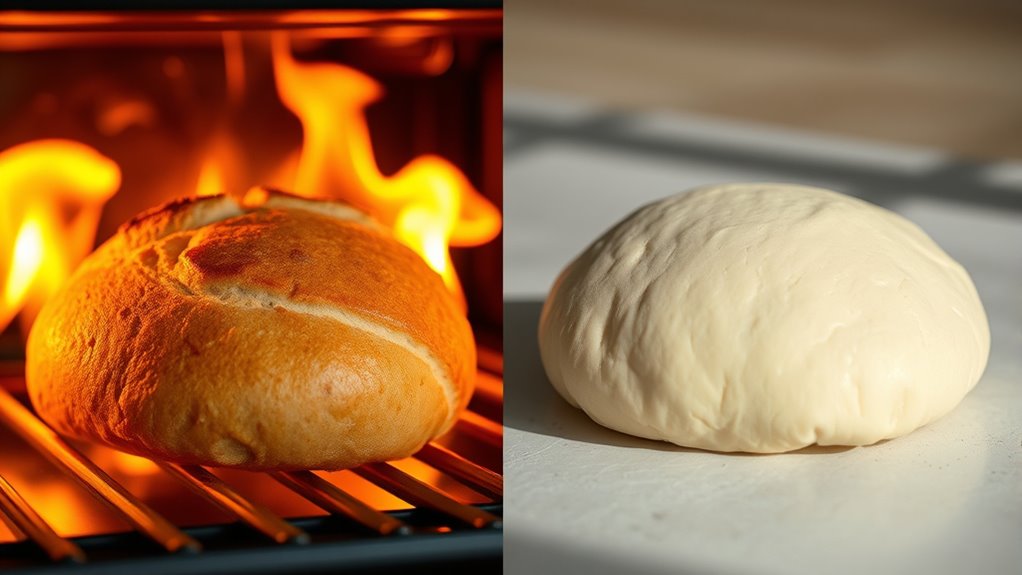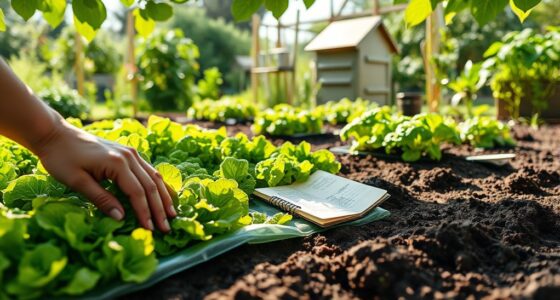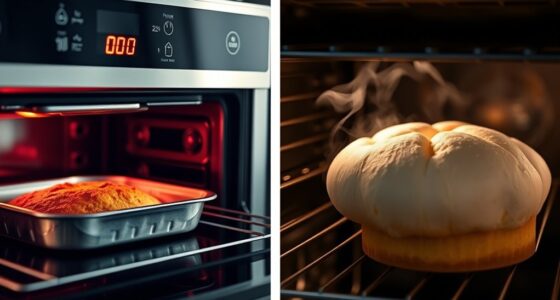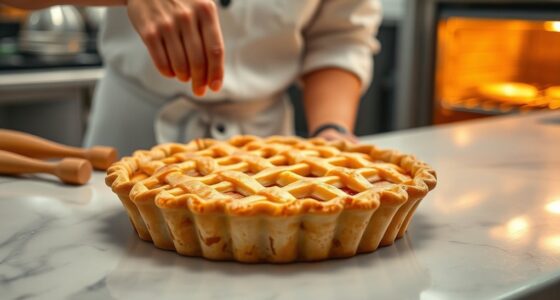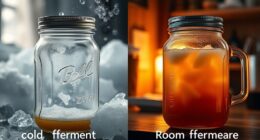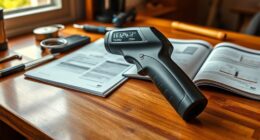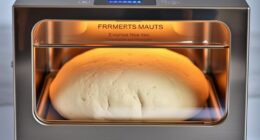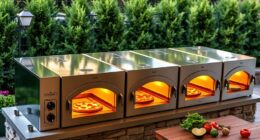When choosing between high and low heat baking, use high heat to quickly develop crispy, golden exteriors on items like bread or gratins, but keep a close eye to prevent burning. Opt for low heat when you want even cooking and moisture retention, especially for delicate dishes like custards or roasts. Knowing when to switch or combine these methods helps you achieve perfectly baked results—keep going to uncover the best techniques for each situation.
Key Takeaways
- Use high heat for crisp, golden crusts and browning; choose low heat for even, moist baking.
- Preheat thoroughly to ensure even heat distribution, regardless of the temperature setting.
- Reserve high heat for finishing touches like broiling or caramelizing; use low heat for gentle, thorough cooking.
- Select appropriate bakeware—dark or heavy-duty pans for high heat, lighter or non-stick for low heat.
- Monitor food closely to prevent burning with high heat, and avoid overcooking with low heat.
When to Use High Heat for Perfectly Crispy and Golden Baked Goods
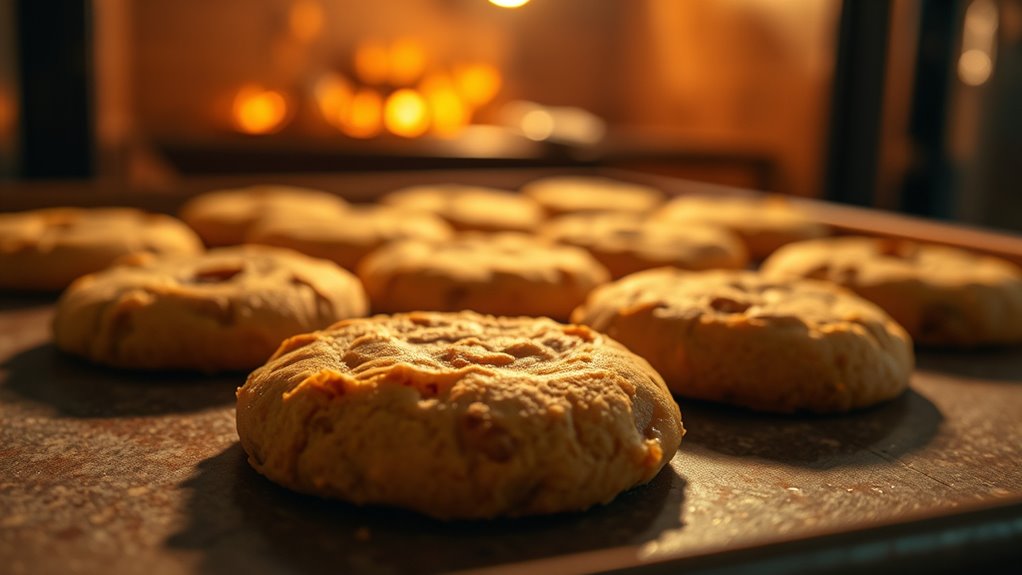
You should use high heat when you want your baked goods to turn out crispy and golden, especially on the outside. Broiler techniques are perfect for adding that crisp finish, particularly for dishes like gratins or breaded items. When using high heat, choose the right baking glassware—preferably dark or heavy-duty pans—that absorb heat efficiently and promote browning. Preheat your oven thoroughly to ensure even heat distribution. Keep a close eye on your food to prevent burning, as high temperatures cook quickly. High heat is also ideal for caramelizing sugars and developing a desirable crust on baked goods like cookies or bread. Remember, use broiler settings sparingly and only when you need that extra crispness on the exterior. Additionally, selecting appropriate bakeware materials can enhance heat transfer and improve browning outcomes.
When to Opt for Low Heat to Ensure Even Cooking and Moisture Retention
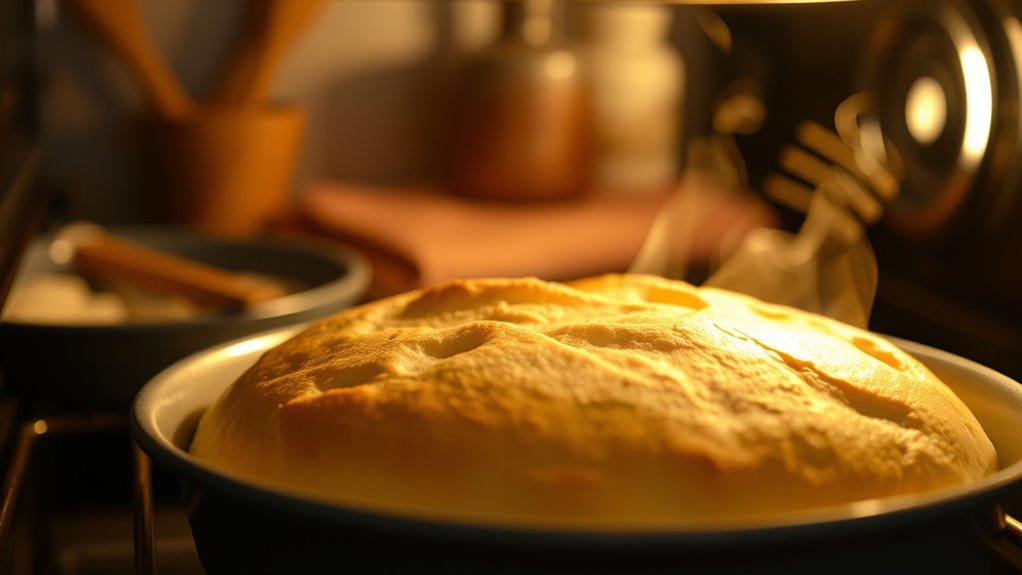
Low heat is ideal when you want to cook food evenly and preserve moisture, especially for delicate dishes like custards, roasts, or casseroles. Using gentle baking or slow roasting prevents the exterior from burning while allowing heat to penetrate thoroughly. This method is perfect for tender cuts of meat or fragile baked goods that require consistent temperature control. When you choose low heat, you give the food time to develop flavors and maintain moisture, avoiding dryness or overcooking. It’s especially useful for dishes that benefit from gradual heat, ensuring even doneness. Detecting passive voice can help improve clarity and make your writing more direct.
Frequently Asked Questions
Can I Switch Between High and Low Heat During Baking?
Yes, you can switch between high and low heat during baking, but be mindful of temperature adjustments to maintain baking consistency. Changing heat levels too often can affect how your baked goods turn out, causing uneven cooking or inconsistent textures. To avoid this, plan your heat adjustments carefully, especially for recipes that require precise temperatures, and make gradual changes to ensure your baked items come out just right.
How Does Oven Type Affect Heat Choice for Baking?
Your oven’s personality shapes your baking journey like a trusted compass. If it’s well-insulated, it maintains steady heat, so choose high or low based on your recipe’s needs. Position your baking rack thoughtfully—closer to the heat source for crispness, farther for gentle baking. Understanding your oven’s quirks guarantees you wield heat wisely, turning each bake into a masterpiece, no matter the oven type.
What’s the Impact of Baking Pan Material on Heat Settings?
Your baking pan material markedly impacts heat settings because of its heat conductivity. For example, metal pans, with high heat conductivity, heat quickly and evenly, so you can use higher temperatures for crispier results. Glass or ceramic pans, with lower conductivity, require lower heat to prevent burning or uneven baking. Adjust your oven temperature accordingly to guarantee even baking and perfect textures based on your pan’s material.
How Does Altitude Influence High or Low Heat Baking?
Altitude effects your baking more than you’d imagine, turning your perfect recipe into a wild adventure! As you rise higher, the air thins, so you must make baking adjustments—like increasing oven temperature or reducing liquids—to prevent cakes from collapsing or drying out. Embrace these altitude effects, and you’ll master high or low heat baking effortlessly, ensuring your treats turn out flawless no matter how high you go!
Are There Health Considerations When Choosing Baking Temperatures?
When choosing baking temperatures, consider food safety and baking safety. Higher temperatures can help kill bacteria and guarantee your baked goods are thoroughly cooked, reducing health risks. Conversely, baking at too low a temperature may leave food undercooked, risking foodborne illnesses. Always follow recommended baking guidelines to ensure safety, maintain proper internal temperatures, and prevent food safety issues. Proper temperature control is key to healthy, safe baking results.
Conclusion
Did you know that using the right heat can cut your baking time by up to 25%? Whether you’re aiming for crispy pastries or evenly cooked bread, choosing high or low heat makes all the difference. Remember, high heat creates that irresistible golden crust, while low heat keeps your baked goods moist and tender. Mastering these techniques will elevate your baking game and guarantee perfect results every time. Happy baking!
